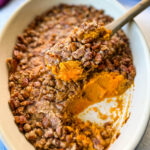
Sweet Potato Casserole with Pecan Topping
Sweet potato casserole with pecan topping is a must-have dish for holiday gatherings and special family dinners. The creamy, velvety base of mashed sweet potatoes, combined with the rich, buttery crunch of the pecan topping, creates an amazing balance of flavors and textures that everyone will love.
Servings 6 cups
Calories 250kcal
Equipment
Ingredients
- 2 ½ -3 pounds sweet potatoes Cooked, mashed, and cooled.
- ½ cup brown sweetener Light or dark will work for this recipe.
- 2 eggs Must be at room temperature.
- 1 teaspoon vanilla
- 4 tablespoons unsalted butter Melted Measured solid, this is ¼ cup
- 1 teaspoon cinnamon
- ½ teaspoon nutmeg
- ½ teaspoon salt
Pecan Streusel Topping
- ¼ cup sweetener or sugar
- ¼ cup flour
- 1 ½ tablespoons unsalted butter
- 1 cup chopped pecans
Instructions
- Preheat oven to 375 degrees.
- Grease a 9x13 baking dish to prevent sticking.
- Combine the mashed sweet potatoes, eggs, butter, vanilla, brown sugar or sweetener, cinnamon, nutmeg, and salt in a mixing bowl.
- Use a hand mixer to blend the ingredients at medium speed. You can also mix by hand or use a blender.
- Pour the sweet potato mixture into the baking dish.
- Combine the pecans, flour, melted butter, and brown sweetener or sugar in a bowl and stir.
- Top the sweet potatoes with the pecan mixture. I like to ensure the casserole is fully covered. You may need a handful more of pecans to completely cover the casserole.
- Bake for 20-25 minutes or until the topping has browned.
- Cool before serving.
Notes
Air fried or baked sweet potatoes work best because they haven't been cooked in water so there is no risk of the dish turning watery.
If you're using boiled or baked sweet potatoes, ensure they are properly drained before mashing or pureeing them. Excess moisture from the cooking process can contribute to a watery casserole. Use a colander to drain the sweet potatoes well and let them sit for a few minutes to release any remaining moisture.
Be careful not to overcook the sweet potatoes, as this can lead to a higher water content. Cook them just until they are fork-tender, and avoid overboiling or overbaking, which can make them mushy and watery.
After baking, let the sweet potato casserole rest for a few minutes before serving. This allows the dish to set and firm up slightly, reducing the likelihood of excess moisture pooling.
Room temperature eggs blend more easily with other ingredients, such as sweet potatoes, butter, sugar, and spices. When eggs are at room temperature, they mix more readily with the other ingredients, resulting in a smoother and more uniform mixture. Cold eggs, on the other hand, can cause the mixture to curdle or result in small lumps.
Nutrition
Serving: 0.5cup | Calories: 250kcal | Carbohydrates: 18g | Protein: 4g | Fat: 17g